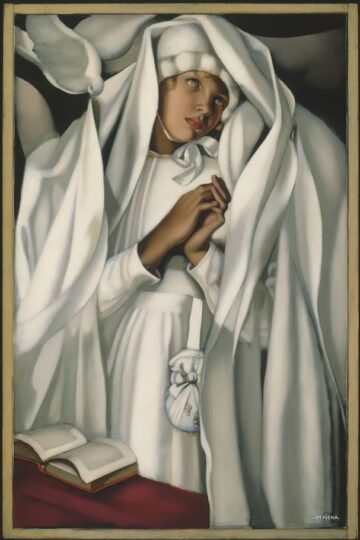
Originally published in The Voice of San Francisco in October 2024
Artist Tamara De Lempicka has become synonymous with the carefree spirit and opulence of the 1920’s. Over 120 works will be on display at the de Young, shining a light on the glamor of the Art Deco era including a number of rarely seen works.
The Preeminent Portrait Painter of the Art Deco Movement
Born in Poland and working for much of her life in France and the United States, Tamara de Lempicka’s paintings combine classical figurative styles with the modern energy of the avant-garde. The bold, geometric forms of Art Deco echo in the stylized hair and fabric represented in paintings like Portrait of Mrs. Rufus Bush, 1929 and Young Girl in Green (Young Girl with Gloves), ca 1931. The figures, and vivid colors of their gowns, are placed in front of angular buildings reminiscent of Art Deco architecture of the period.
Chapters in the Life of an Artist
This polished technique and graphic use of line makes Lempicka’s works instantly recognizable. The exhibit is presented chronologically, marking the four major stages of the artist’s life through her changing identity. Born Tamara Rosa Hurwitz, she was also known as Monsieur Lempitzky, Tamara de Lempicka and Baroness Kuffner. Each section makes note of the most prevalent themes of her artistic style at that time.
While organizing this exhibition, curatorial research uncovered crucial and unpublished biographical aspects of Lempicka’s life. Tamara Rosa Hurwitz was born to a Polish family of Jewish descent in 1894. After moving to Russia with her family, she married Tadeusz Lempicki in 1916 with their only daughter, Marie Christine “Kizette” born that year. They divorced in 1929 and Lempicka continued to use her first husband’s name to sign her artworks throughout her life.
France and the United States
After the turmoil of the Russian Revolution in 1917, Lempicka fled to Paris, arriving in 1919 and staying throughout the 1930’s. She was an openly bisexual, cosmopolitan polyglot who lived throughout Europe but thrived in Paris, and effortlessly took on the identity and lifestyle of a carefree trendsetting Parisian. She began using the male declination of her surname, “Lempitsky”, effectively disguising her gender and adding confusion to her story of origin.
“The combination of varied artistic influences in Europe during the interwar period constitute the ingredients for Lempicka’s unique visual language, a captivating and unique blend of classicism and modernism,” explained Gioia Mori, exhibition co-curator.
“After decades of research, this exhibition constituted the opportunity to investigate Lempicka’s first sojourn in the United States in the spring of 1929. She first arrived in New York and then traveled to Santa Fe and San Francisco. In San Francisco, she exhibited in 1930 at the then-renowned Galerie Beaux Arts. Lempicka’s relationship with San Francisco continued through 1941 when she exhibited a selection of her latest works at Courvoisier Gallery on Geary.”
Traveling in the course of exhibiting her paintings may have saved her life. A pivotal moment came when she remarried in 1934 to Baron Raoul Kuffner de Dioszegh, a Hungarian-Jewish nobleman from present-day Slovakia. Then in February 1939, Lempicka left Paris for the United States to attend an exhibition organized in New York. This trip saved her from witnessing the tragic Nazi occupation of Poland and Paris in 1939 and 1940. During this time period she painted melancholic still lives of domestic interiors utilizing a polished pictorial technique and process Lempicka sourced form masters of Italian and Flemish painting.
Living in Beverly Hills and New York City, she eventually joined her daughter Kizette in Houston. Lempicka enjoyed a kind of renaissance in the 1970’s during which she was hailed as an Art Deco Icon. She died at her home in Cuernavaca, Mexico in 1980.
Never-Before Seen Art and Ephemera
The Fine Arts Museum recently acquired a drawing of Lempicka’s daughter Kizette which will be on view to the public for the first time. A selection of Art Deco objects, sculptures and dresses from the Fine Arts Museum’s collection will provide perspective on the artist’s process and place in history. The exhibit has a special section on the relationship between the artist and fashion demonstrated through the works she produced for the German fashion magazine Die Dame including the famous cover Self-Portrait on a Green Bugatti. Tamara de Lempicka embodied the independence and dynamic of the “New Woman” carving a path through art and fashion utilizing her own personal style to establish her singular place in history.